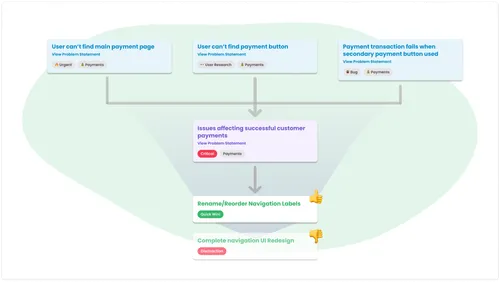23 July, 2025
Most teams are drowning in customer feedback, but the real challenge is turning that noise into clear, actionable insights. Learn how to spot what matters, avoid common traps, and use simple techniques to make sense of the feedback you already have.
If you're a product manager or part of a UX-focused team, you probably have more customer feedback than you know what to do with. The real problem isn't collecting feedback - it's figuring out what's actually important. Teams often chase the loudest complaints or the most recent requests, but that's rarely the best way to drive your product forward.
The challenge isn't getting more feedback. It's making sense of what you already have.
It's easy to get distracted by the noisiest feedback - whether it's a passionate user, a senior stakeholder, or a bug that's been flagged for the tenth time. But volume and urgency don't always equal impact. The loudest voice in the room might not represent the majority of your users, and chasing every squeaky wheel can lead to wasted effort and missed opportunities.
Instead, look for patterns and recurring themes. If you notice the same friction points popping up across different channels - support tickets, sales calls, user interviews - that's a sign you've found a real problem worth solving. Don't let a single vocal user dictate your roadmap. Balance individual requests with the broader needs of your user base.
Start by grouping similar feedback together. Are multiple users struggling with onboarding? Do you see repeated complaints about a specific workflow? Use tags or categories in your insight management tool to cluster related feedback, making it easier to spot trends.
Example:
These all point to a single usability issue, even if the wording is different. When you see the same theme in different places, you've found a pattern worth investigating.
Don't just collect feedback - organize it. Use simple tags like "feature request", "bug", or "usability" to group feedback by type. Then, cluster related items together. This helps you see which problems are widespread and which are isolated.
A basic spreadsheet or putting insights into folders in a tool like Voyce can make this process painless. The goal is to make feedback scannable and actionable, not just a pile of notes.
Actionable insights come from decoding, clustering, and tagging feedback - not just collecting it.
Sometimes, the most valuable feedback is hidden. Look for users describing workarounds or expressing frustration in subtle ways. If someone says, "I have to copy data into Excel to get what I need", that's a sign your product is missing a key feature.
Pay attention to:
Once you've clustered and tagged your feedback, it's time to turn insights into action. Focus on writing clear problem statements. Record the user's context, what they're trying to achieve, and what's getting in their way.
Prioritize issues using simple metrics: How many users are affected? How severe is the problem? Don't get bogged down in complex frameworks - start with what's easy to use and explain.
Once you've defined and prioritized your most pressing problems, you're ready to move from problems to solutions. Before jumping into ideation, though, take a moment to validate your top problems. Double-check that they're based on real user needs and not just assumptions. Share your findings with your team or stakeholders to get alignment and buy-in. Involve people from different functions - engineering, design, support, and sales. Get a range of perspectives on the problem space.

Set up a dedicated session or workshop to brainstorm solutions. Make sure everyone understands the problem statements and why these issues matter. Encourage open discussion and creative thinking, and keep the focus on solving the real, validated problems you've surfaced. This preparation ensures that your ideation efforts are targeted, collaborative, and more likely to result in solutions that truly address your users' needs.
You don't need a research team or fancy software to get started, but the right tool can make a big difference. Voyce helps you:
The result? Less time spent wrangling spreadsheets, more time acting on what matters. And because Voyce is built for normal teams - not just researchers or designers - it's easy to get started and see value right away.
You already have the feedback you need to make better product decisions. The challenge is turning that noise into clear, actionable insights. By spotting patterns, clustering feedback, and focusing on real user problems, you'll move from overwhelmed to in control.
If you want to see how easy it can be, sign up for a free trial of Voyce and start turning feedback into product wins.
Stay in touch for updates and ideas.
No spam. No advertising. No rubbish. Just us.